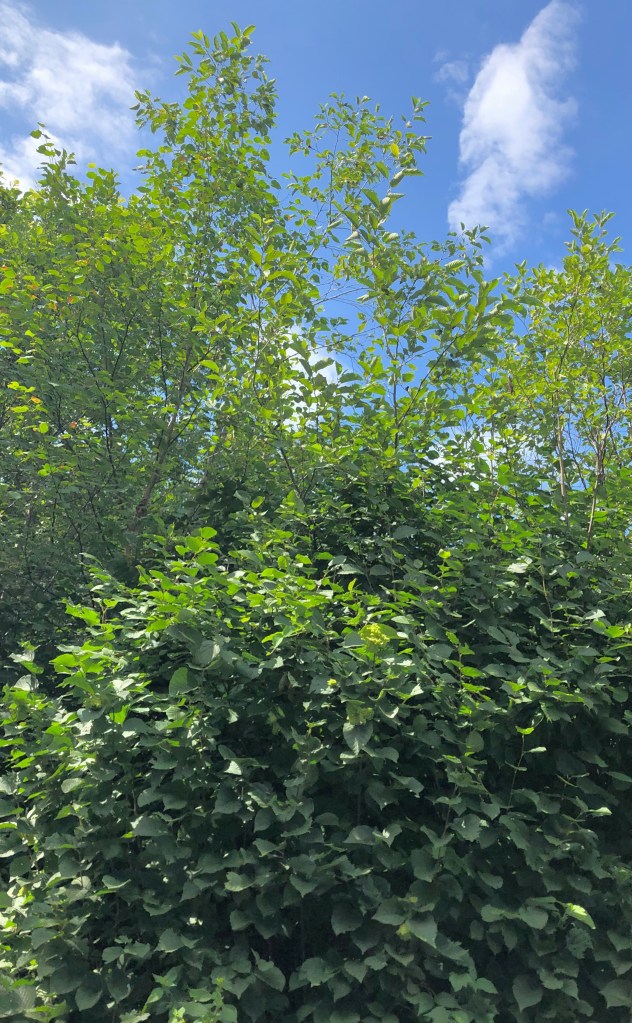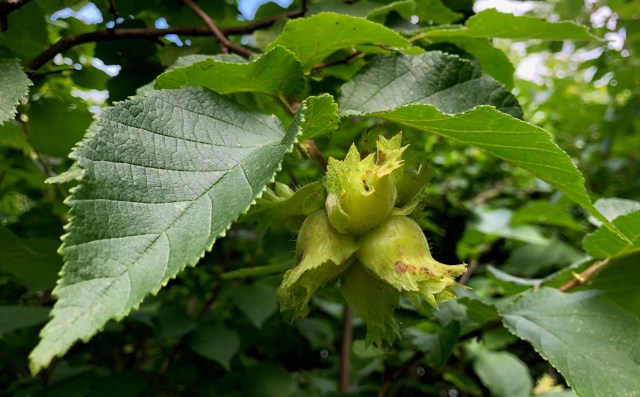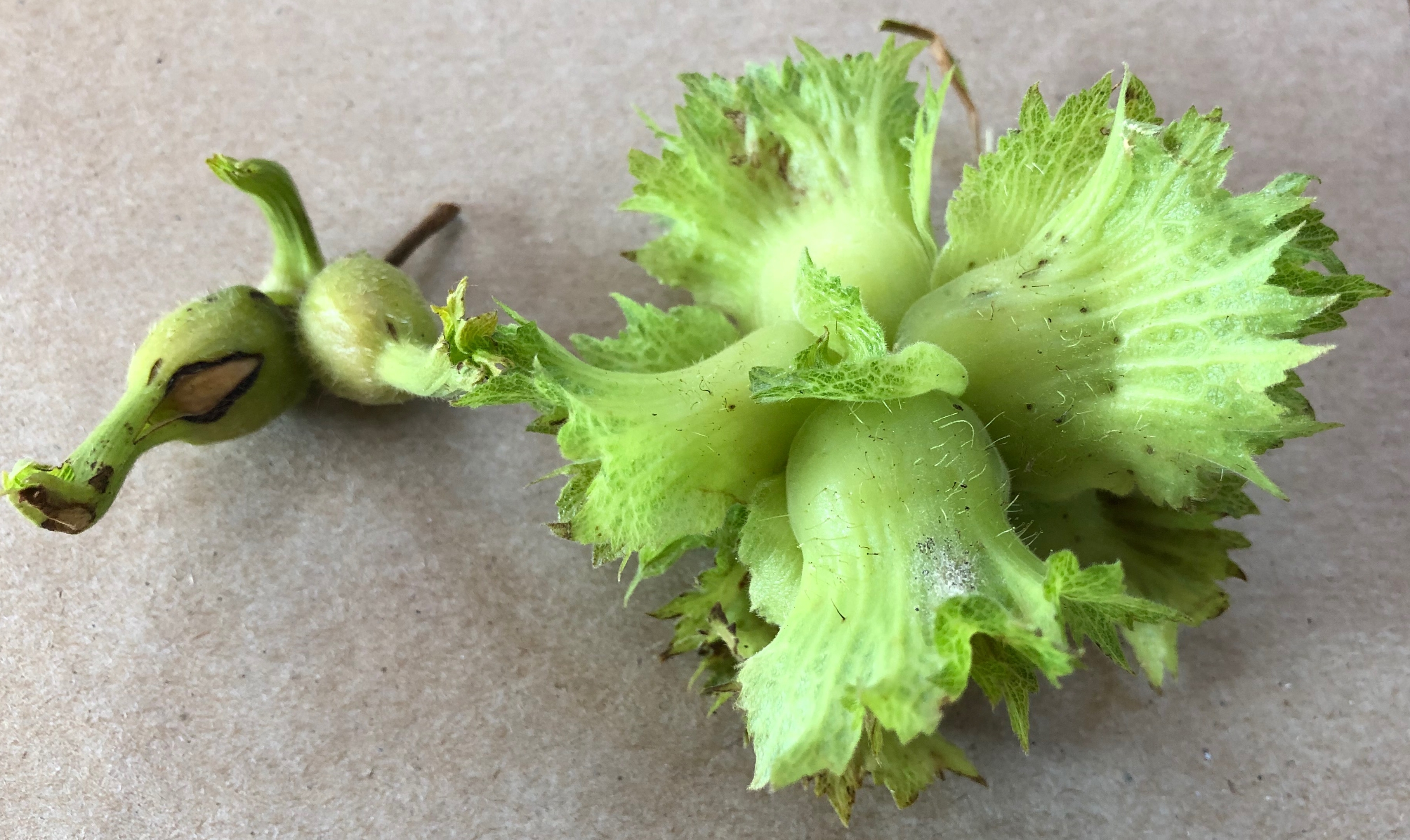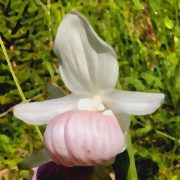The perimeter of our lake has a nearly continuous natural hedge. The picture below shows this continuous wall of bushes rimming one of the lake’s islands. This bushy barrier at the water’s edge is predominantly Gray Alder.


Gray Alder (Alnus incana)
According to the Minnesota DNR, many smaller lakes and ponds in northern Minnesota are ringed by thickets of Gray Alder — commonly called Speckled Alder because of the scattered white lenticels on its stems. It prefers wet areas, which explains its prevalence on the shoreline. It has no commercial uses, but does provide erosion control. Plus, its branches seem to be a favorite of beavers.
Gray Alder flowers in early spring, the cylindrical clusters of its small flowers are called catkins. Female catkins develop into the small cones seen in the center of the photo to the left.
Gray Alder and Hazelnut
Gray Alder and Hazelnut are both in the birch family (Betulaceae). Grey Alder is everywhere along our lakeshore, while Hazelnut bushes seem to be absent right next to the water.
The picture to the right shows an area a few yards from the lake’s edge. Taller Gray Alders are towering over shorter, darker-green Hazelnut bushes. Further away from shore, the Hazelnut predominates in the understory.
Two species of Hazelnut coexist here, the American Hazelnut and the Beaked Hazelnut. They are described below.


American Hazelnut (Corylus americana)
The American Hazelnut bush bears hard-shelled nuts encased by stiff green bracts. In late summer the nuts grow so that they are exposed through the bracts and change color to brown. The nuts are smaller than commercially-grown hazelnuts (filberts), but they are tasty. Squirrels, chipmunks, and other animals will be in competition with you for the nuts.


Beaked Hazelnut (Corylus cornuta)
Beaked Hazelnut is very similar to American Hazelnut, the major difference is the beak-shaped husk surrounding the nuts on this plant.
Reportedly, Beaked Hazelnut prefer areas a bit wetter than American Hazelnuts. However, I find them growing intermingled, with no discernable preferences. For both species, bushes getting abundant sunlight produce noticeably more nuts.

Below are two pictures, each a side-by-side comparison of Beaked and American Hazelnuts (as of July 31). The image on the left show the nuts still in their husks, and the image on the right shows the nuts with husks removed. The two nuts from the Beaked Hazelnut appear more mature than the six nuts from the American Hazelnut cluster. The nuts are smaller than commercially grown hazelnuts, but once they ripen in late summer they are every bit as edible. Websites are available to help you find, harvest, and prepare wild hazelnuts,


Could hazelnuts be a profitable crop in the Upper Midwest?
The Upper Midwest Hazelnut Development Initiative (UMHDI) is a group promoting hazelnut cultivation as a new crop in the Upper Midwest. Their website contains a wealth of information about hazelnuts. Here is a list of interesting facts:
- The top hazelnut producer in the world, by far, is Turkey. This production is from the European hazelnut; a plant that is more tree-like than native North American hazelnuts.
- 99% of the current US hazelnut production is from Oregon.
- Various hybrid crosses of the American, Beaked, and European Hazelnuts are being tested in the Midwest in hopes of finding an economically viable cultivar.
- Hazelnut oil is 81% oleic acid, which makes it very heart healthy; it is also well-suited for production of biodiesel fuel. Hazelnut has the potential to become the first perennial oilseed crop in the Midwest, a big plus for sustainability.
